The Gross Regional Domestic Product (GRDP) is an economic barometer of the regional economies. GRDP utilizes the production approach that measures the the economic performance of a region. GRDP covers the value of goods and services produced in a region.
The GRDP includes regional estimates on the three major industries of the economy including their sub-industries. The three major industries are Agriculture, Forestry, and Fishing (AFF), Industry and Services.
The GRDP is presented in nominal and real terms. Nominal GRDP measures the value of the outputs of the economy at current prices while real GRDP or at constant prices measure the value of economic outputs using the prices of a fixed base year. The GRDP is usually reported in real terms or constant prices since the effects of inflation are removed.
The Regional Accounts of the Philippines (RAP) presents the regional breakdown of the economic performance of the country. There are two approaches in economic estimation: Gross Regional Domestic Product (GRDP) and Gross Regional Domestic Expenditure (GRDE). GRDP presents the aggregate gross value added (GVA) of all producer units in the region. On the other hand, GRDE is intended to complement the current series of the GRDP and is defined as the expenditure of residents of the region in the domestic territory plus their expenditures in other regions including the rest of the world.
This report will focus on the 2022 economic performance of Cordillera in comparison to the 16 regions in the country using the production approach.
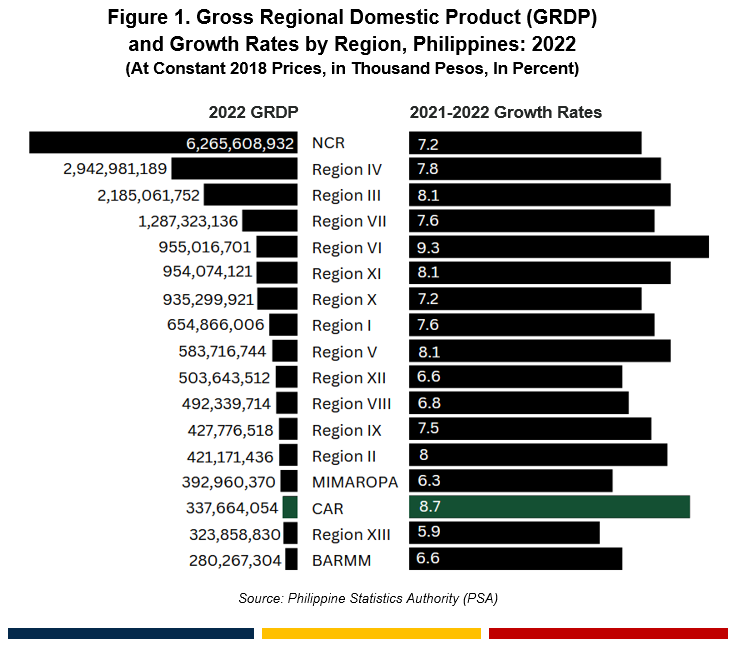
CAR ranks 2nd in GRDP growth rate
The economy of the Cordillera Administrative Region is continually recovering from the COVID-19 pandemic with a recorded growth of 8.7 percent in 2022, making it the second fastest-growing regional economy among the 17 regions in the country. Region VI (Western Visayas) ranked first with 9.3 percent growth rate.
In terms of total regional economic output, four regions produced a trillion worth of goods and services, namely: NCR, Region IV, Region III, and Region VII. Cordillera had the third lowest GRDP with 337.7 billion pesos.
There were seven regions that did not achieve half a trillion worth of economic output, namely: Eastern Visayas, Zamboanga Peninsula, Cagayan Valley, MIMAROPA, CAR, CARAGA, and BARMM.
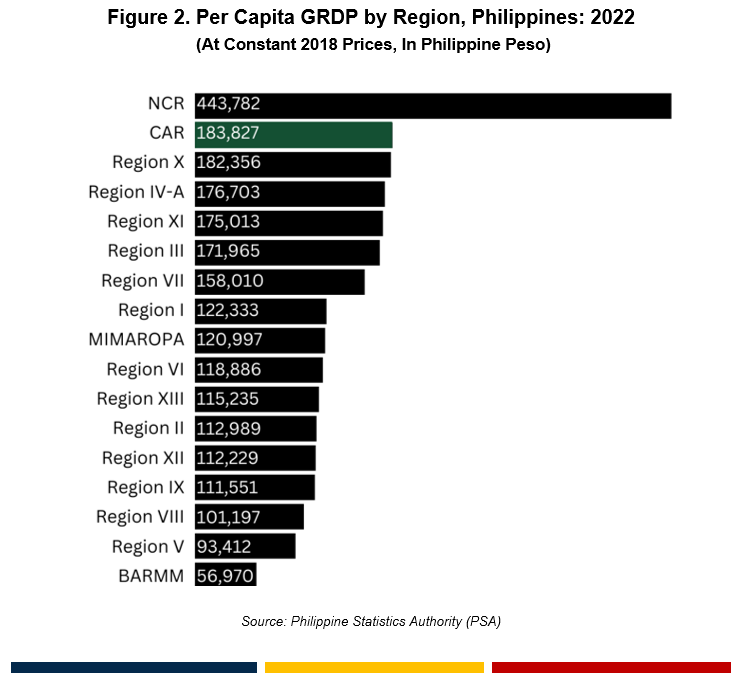
Cordillera records 2nd highest regional per capita GRDP
In terms of per capita regional economic output, the National Capital Region (NCR) had the largest per capita GRDP with 443,782 pesos, followed by Cordillera Administrative Region (CAR) and Northern Mindanao Region with 183,827 pesos and 182,356 pesos, respectively.
In addition, there were two regions that did not achieve a hundred thousand worth of per capita economic output, namely: Bicol Region and BARMM with 93,412 pesos and 56,970 pesos, respectively.
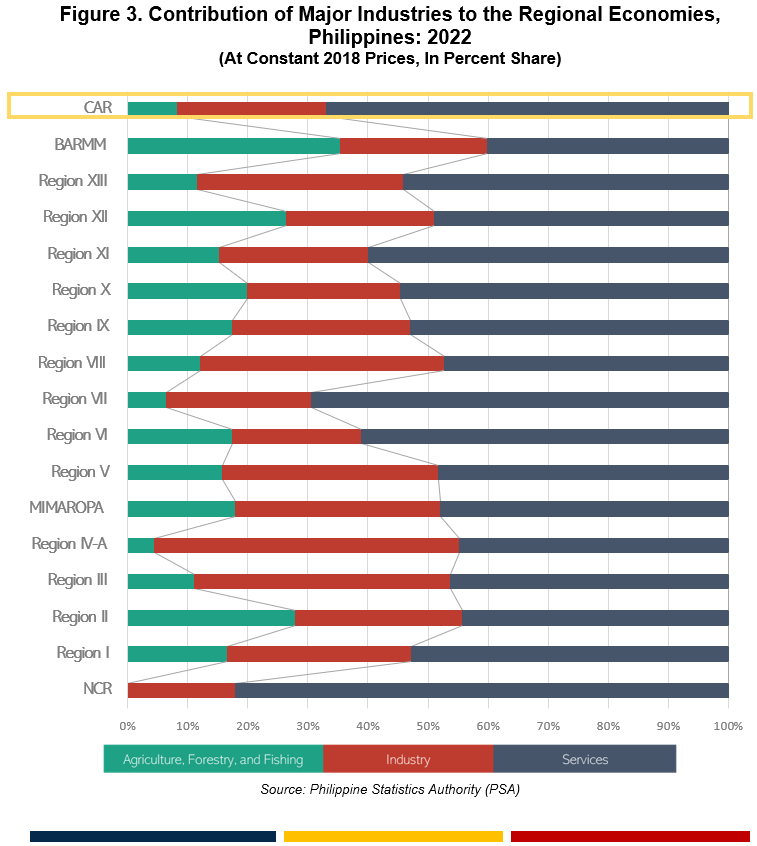
CALABARZON stands as sole industry-focused region
As to distribution of major industries, 16 out of the 17 regions in the Philippines, including Cordillera were predominantly Services-based.
The region of Cordillera ranked 16th in Agriculture, Forestry, and Fishing (AFF) with GVA of 28.12 billion pesos; ranked 16th as to its Industry with GVA of 83.9 billion pesos; and ranked 13th as to its Services with GVA of 225.6 billion pesos.
With a GVA of 434.2 million pesos in AFF, NCR was the only region with a major industry that falls short of reaching a billion-peso production mark.
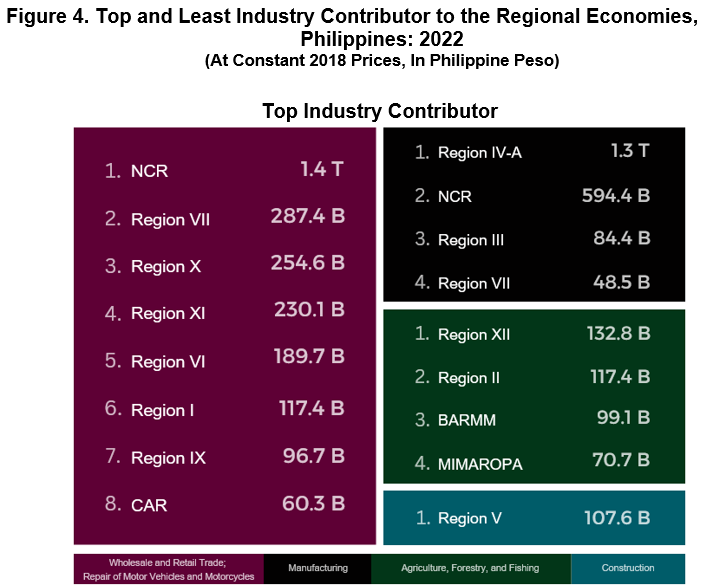
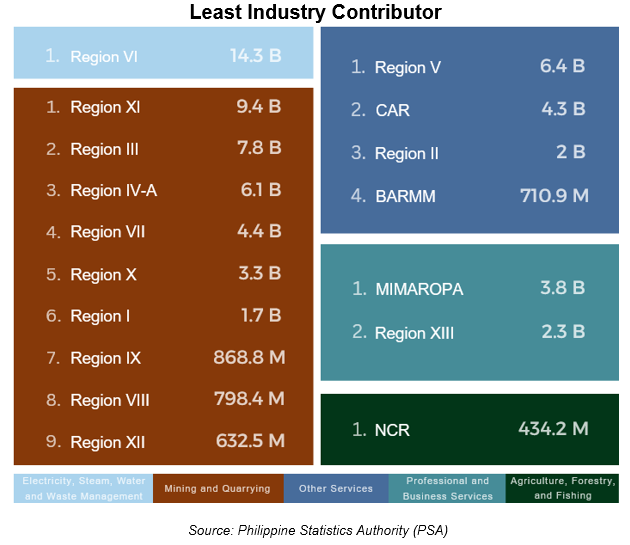
As to contributors to the regional economy, eight regions including Cordillera were Wholesale and Retail Trade-driven, four regions were Manufacturing-focused, four were AFF-rooted, and only Bicol Region was Construction-based.
As to least industry contributor, Cordillera had Other Services as its industry with the lowest GVA with an output of 4.3 billion pesos.
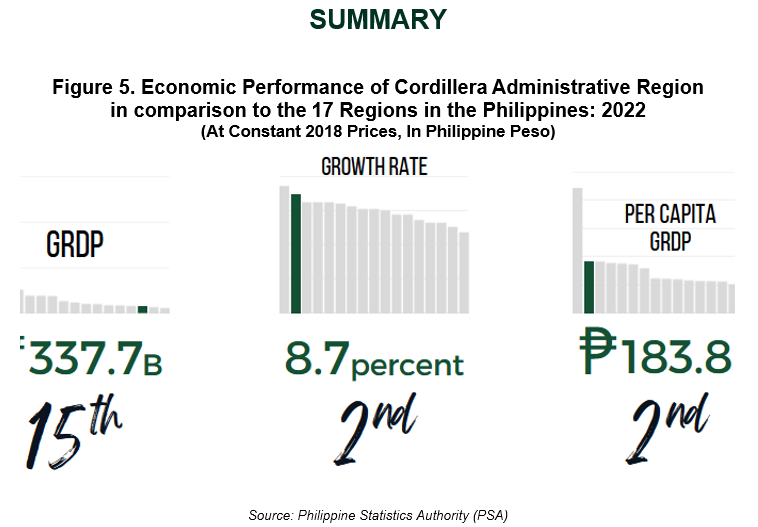
With GRDP valued at 337,664,054,000 pesos, the region of Cordillera ranked 15th among the among the 17 regions in the Philippines in terms of economic production. In addition, Cordillera was the 2nd fastest-growing regional economy with 8.7 percent growth, and reported the 2nd highest per capita GRDP with 183,827 pesos.
(SGD)
ALDRIN FEDERICO R. BAHIT, JR.
(Chief Statistical Specialist)
Officer-in-Charge
_______________________________________
TECHNICAL NOTES
Gross Provincial/City Domestic Product (GPDP/GCDP)
- The aggregate of gross value added (GVA) of all resident producer units in a province/city.
- Measures the economic performance of the province/city from the perspective of the producers of goods and services. It covers the value of goods and services produced in the region during the reference period.
- GPDP/GCDP measures the relative contribution of the 16 highlighted industries under the Philippine Standard Industrial Classification (PSIC), namely:
- Agriculture, Forestry, and Fishing (AFF)
- Mining and Quarrying (MAQ)
- Manufacturing (MFG)
- Electricity, Steam, Water and Waste Management (ESWW)
- Construction (CNS)
- Wholesale and retail trade; repair of motor vehicles and motorcycles (TRD)
- Transportation and storage (TAS)
- Accommodation and food service activities (AFSA)
- Information and communication (IAC)
- Financial and insurance activities (FIA)
- Real estate and ownership dwellings (REOD)
- Professional, and business services (PBS)
- Public administration and defense; compulsory social activities (PAD)
- Education (EDUC)
- Human health and social work activities (HHSW)
- Other services (OS)
Constant prices
● way of measuring the real change in output. A year chosen as the base year. For any subsequent year, the output is measured using the price level of the base year. This excludes any nominal change in production and enables a comparison of the actual goods and services produced.
Growth Rate
● refers to the percentage change of a specific variable within a particular time.
Percent Distribution
● means the percentage obtained by dividing the aggregate value of the Share Consideration (determined by reference to the Closing Share Price) by the Aggregate Consideration Value.
Per Capita GDP
· a financial metric of the economic output per person and is calculated by dividing the GDP by its population.

